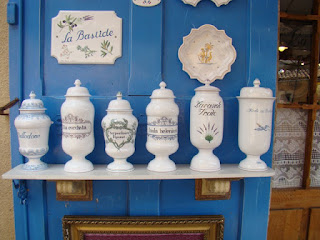Last week I
escorted a group for a day trip over the Valensole plateau. It’s a tour that I
don’t do often enough with tourists, as the majority want to stay on the
western side of Provence in the Luberon valley, and so it remains for me more often a
family outing.
So let me
try to tempt you…
 |
| One of the vast Lavender fields on the Plateau de Valensole |
 |
| A wild almond photographed in Haute Provence in May 2012 |
 |
| A view of the village of Moustiers Ste Marie |
We continue
across the Plateau with our next destination being Moustiers Ste Marie. This
picture postcard town set against the rocks, which if you follow to the right, will
lead you into the Verdon Gorges (another article coming on these too) is
dominated by a star hung between two rock ledges on a huge chain. The original
star was hung by the Blacasset, a soldier and troubadour who vowed that if he
returned to Provence after his capture during the seventh crusade he would erect
a shrine to the Virgin Mary. This he did in the form of a 16 pointed star,
emblem of the family, hung on a chain over the village of Moustiers which today
800 years on and after a few falls and restorations still hangs proud, but with
only 5 stars now.
Moustiers is also famed for its pottery or Faience and the
town is dotted with shops offering their beautiful creations, with the unique blue/white
glaze typical to the town.
 |
| One of the many shop fronts in Moustiers Ste Marie selling the famous Faience de Moustiers |
 |
| The village of Ste Croix du Verdon |
For the
continuation of this article let’s go with the simpler picnic by the lake. The Lac de Ste Croix is the fourth largest
man-made lake in France covering 2200 hectares. It was filled in 1973,
submerging the village of Les Salles sur Verdon (a new one was later built on
the banks of the lake). At one end of the lake is the entrance to the Verdon
Gorges and it is the Verdon River that feeds the lake, at the other end on the
other side of the Dam are the smaller Gorges du Baudinard which are a delight
to canoe up on a hot summer day. Heading down to the village of Ste Croix du Verdon, when
you first see the lake it is the turquoise blue colour of the water that catches
the eye, this incredible hue is due to the beige coloured stone on the lakes
bottom, which makes the crystal clear water of the Verdon blue with the
refraction of the sunlight. You can get into the holiday swing of things by
renting a pedalo or an electric boat (no engines on the lake) or a Hobie Cat
when the wind picks up in the afternoon. Following the path along the lake side
there are plenty of shady spots away from the crowds to picnic and swim, but
beware, even though the water close to the banks and on the surface is warm, it
is very cold just below. There is no sand to speak of but medium sized pebbles
so some form of waterproof footwear is a good idea. Also it is strictly forbidden
to light any form of fire, and if you try, the park wardens will be there in
minutes! The lake is regularly used by the Canadairs, the famous French airborne
fire fighting team, and watching the planes pick up water on the lake is a very
impressive sight indeed.
If you
would like to know more about touring the Valensole plateau and beyond (only a
tiny bit of the treasures of this region have been covered in this article)
then use the contact form here, and it would be with great pleasure that we can help
you plan a trip to this magical part of Provence.


No comments:
Post a Comment
Post your comments here, comments are open to all but are subject to moderation